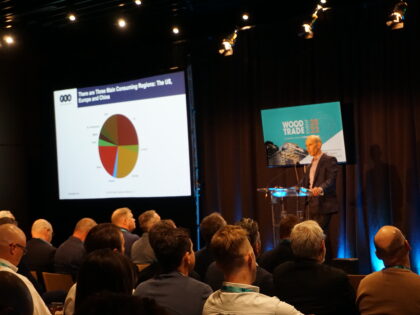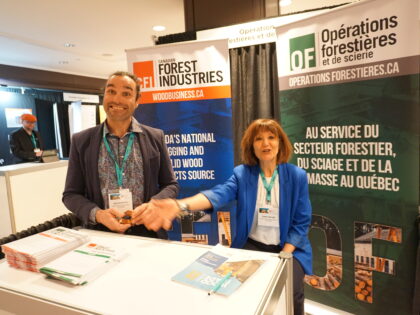
Features
Economy, futures and inflation took centre stage at MWC
The convention attracted 1,100 participants from around the world and featured 110 booths
April 24, 2023 By Jennifer Ellson
 The 2023 Montreal Wood Convention attracted 1,100 participants and featured 110 booths. Photo: Annex Business Media.
The 2023 Montreal Wood Convention attracted 1,100 participants and featured 110 booths. Photo: Annex Business Media. Speakers comprising leading economists and forest industry executives discussed the global economic and industry outlook at the 2023 Montreal Wood Convention (MWC), held at the Fairmont Queen Elizabeth Hotel in Montreal, Que., from April 18 to 20.
The convention attracted 1,100 participants from around the world and featured 110 booths showcasing the latest trends, technologies, and products by the biggest companies in the industry, making it one of the largest gatherings of its kind in North America.
The three-day event featured several sessions that focused on the economy and the markets. “We believe this event will help companies run their business more efficiently and drive industry growth,” said Sven Gustavsson, manager of softwoods for the Quebec Wood Export Bureau (QWEB) and MWC event manager.
CIBC’s deputy chief economist Benjamin Tal opened the sessions on Wednesday morning talking about inflation and the outlook of the global economy.
“Inflation is like the brown spot in a banana – by the time you see it, it’s already too late,” he said.
Tal said the housing market is the number one factor impacting the Canadian wood industry.
“The current estimate for new immigrants settling permanently in Canada is at around one million per year, and none of them are carrying their houses on their backs, so new housing is needed urgently.” He added that renting must be a part of the solution and that governments must provide incentives to developers to encourage housing construction.
“If the Fed stops raising interest rates, the construction market will be fine and this will be the case in 2024 and 2025,” Tal said.
Paul Jannke, principal, Forest Economic Advisors, said global lumber consumption slipped in 2022 and will slip again in 2023. This resulted to a significant decline in lumber prices at the end of 2022 and so far in 2023, but the market is expected to rebound in 2024.
In addition, the changing fibre supply patterns will affect production both in the short and long-term. The war in Ukraine and fibre supply will also change global supply chains.
“The world had excess fibre in the U.S. South and Russia. One of those regions will be taken out of the western supply chain for years while the other faces labour supply shortages,” he said.
However, near-term market weakness is likely to fade once demand rebounds because of global supply limitations.
“After a decline of 16% in 2023, the market is expected to grow by 14% in 2024,” Jannke told delegates at the standing-room only session.
Attendees also learned more about using the lumber futures as a risk management tool, which have now become more accessible to North American producers due to the implementation of new operating rules.
On Wednesday noon, Super Bowl champion and medical doctor Laurent Duvernay-Tardif inspired the delegates with his journey from professional football to medical school. The NFL player for the New York Jets discussed the importance of leadership, perseverance, and adaptability when he opted out of his lucrative contract in playing football to serve as an orderly at a long-term care facility in his native Quebec during the COVID-19 pandemic.
On Thursday morning, attendees were treated to a CEO-panel discussion on the challenges facing the industry.
Dan Starr, president of Do-It Best Corp., one of the largest hardware chains in the United States, said demand will explode when interest rates stabilize. “There’s almost no home inventory and when you look at the demographics, there’s a lot of young people in their prime who will want to build a home,” he said.
Starr warned that this can lead to the same difficulty that happened during the pandemic, when demand skyrocketed, as prices soared.
“Instead of having prices on a roller coaster, it would be better to have a more stable demand and prices,” he explained.
Russ Permann, CEO of Taiga Building Products, a Canadian hardware chain with sales of $2.2 billion, agreed. “It’s expensive to keep big inventories, because for the first time in a long time, money is expensive,” he said, referring to rising interest rates. Like Starr, Permann warned that demand will rise steeply, “and we will be back in the same place as during the pandemic.”
Sylvain Labbé, QWEB president and CEO and a member of the organizing committee, said MWC reconfirms its role as the key Canadian hub for producers, wholesalers, and retailers of wood products.
“We are delighted with the record participation from the United States and Canada, as well as the significant presence from overseas markets,” he said.
Print this page





